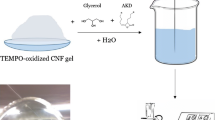Abstract
In the present study, CNF prepared by TEMPO-mediated oxidation and enzymatic hydrolysis were used for the production of nanopapers using a papermaking-like route. Nanopapers were characterized in terms of tensile, thermal, optical and morphological properties. Those prepared from enzymatically hydrolyzed CNF were found to be weaker at tensile than those resulting from TEMPO-mediated oxidation, but with similar level of stiffness. Enzymatically obtained CNF presented lower transparency due to their higher diameter and lower fibrillation yield. Moreover, TEMPO-oxidized CNF presented lower onset of the thermal degradation temperature (230 °C) due to the presence of carboxylic groups. Overall, the influence of increasing the amount of enzyme during enzymatic hydrolysis and the amount of sodium hypochlorite during TEMPO-mediated oxidation was assessed as function of the ultimate properties of nanopapers.






Similar content being viewed by others
References
Althues H, Henle J, Kaskel S (2007) Functional inorganic nanofillers for transparent polymers. Chem Soc Rev 36(9):1454–1465
Besbes I, Alila S, Boufi S (2011) Nanofibrillated cellulose from TEMPO-oxidized eucalyptus fibres: effect of the carboxyl content. Carbohyd Polym 84(3):975–983
Chun S-J, Lee S-Y, Doh G-H, Lee S, Kim JH (2011) Preparation of ultrastrength nanopapers using cellulose nanofibrils. J Ind Eng Chem 17(3):521–526
Dankovich TA, Gray DG (2011) Contact angle measurements on smooth nanocrystalline cellulose (I) thin films. J Adhes Sci Technol 25(6–7):699–708
de Marco JL, Felix CR (2007) Purification and characterization of a beta-glucanase produced by Trichoderma harzianum showing biocontrol potential. Braz Arch Biol Technol 50(1):21–29
Delgado-Aguilar M, González I, Tarrés Q, Alcalá M, Pèlach MÀ, Mutjé P (2015a) Approaching a low-cost production of cellulose nanofibers for papermaking applications. BioResources 10(3):5345–5355
Delgado-Aguilar M, Tarrés Q, Puig J, Boufi S, Blanco Á, Mutjé P (2015b) Enzymatic refining and cellulose nanofiber addition in papermaking processes from recycled and deinked slurries. BioResources 10(3):5730–5743
Eriksen O, Syverud K, Gregersen O (2008) The use of microfibrillated cellulose produced from kraft pulp as strength enhancer in TMP paper. Nord Pulp Pap Res J 23(3):299–304
Espinosa E, Tarrés Q, Delgado-Aguilar M, González I, Mutjé P, Rodríguez A (2016) Suitability of wheat straw semichemical pulp for the fabrication of lignocellulosic nanofibres and their application to papermaking slurries. Cellulose 23(1):837–852
Ferrer A, Quintana E, Filpponen I, Solala I, Vidal T, Rodríguez A, Laine J, Rojas OJ (2012) Effect of residual lignin and heteropolysaccharides in nanofibrillar cellulose and nanopaper from wood fibers. Cellulose 19(6):2179–2193
Henriksson M, Henriksson G, Berglund L, Lindström T (2007) An environmentally friendly method for enzyme-assisted preparation of microfibrillated cellulose (MFC) nanofibers. Eur Polym J 43(8):3434–3441
Henriksson M, Berglund LA, Isaksson P, Lindstrom T, Nishino T (2008) Cellulose nanopaper structures of high toughness. Biomacromol 9(6):1579–1585
Hu L, Zheng G, Yao J, Liu N, Weil B, Eskilsson M, Karabulut E, Ruan Z, Fan S, Bloking JT (2013) Transparent and conductive paper from nanocellulose fibers. Energy Environ Sci 6(2):513–518
Hubbe MA (2014) Prospects for maintaining strength of paper and paperboard products while using less forest resources: a review. BioResources 1(9):1787–1823
Isogai A, Saito T, Fukuzumi H (2011) TEMPO-oxidized cellulose nanofibers. Nanoscale 3(1):71–85
Jorfi M, Foster EJ (2015) Recent advances in nanocellulose for biomedical applications. J Appl Polym Sci 132(14). doi:10.1002/app.41719
Lizundia E, Delgado-Aguilar M, Mutjé P, Fernández E, Robles-Hernandez B, de la Fuente MR, Vilas JL, León LM (2016) Cu-coated cellulose nanopaper for green and low-cost electronics. Cellulose 23(3):1997–2010
Naderi A (2017) Nanofibrillated cellulose: properties reinvestigated. Cellulose 24(5):1933–1945
Naderi A, Lindström T, Pettersson T (2014) The state of carboxymethylated nanofibrils after homogenization-aided dilution from concentrated suspensions: a rheological perspective. Cellulose 21(4):2357–2368
Olsson RT, Samir MA, Salazar-Alvarez G, Belova L, Ström V, Berglund LA, Ikkala O, Nogues J, Gedde UW (2010) Making flexible magnetic aerogels and stiff magnetic nanopaper using cellulose nanofibrils as templates. Nat Nanotechnol 5(8):584–588
Österberg M, Vartiainen J, Lucenius J, Hippi U, Seppälä J, Serimaa R, Laine J (2013) A fast method to produce strong NFC films as a platform for barrier and functional materials. ACS Appl Mater Interfaces 5(11):4640–4647
Saito T, Kimura S, Nishiyama Y, Isogai A (2007) Cellulose nanofibers prepared by TEMPO-mediated oxidation of native cellulose. Biomacromolecules 8(8):2485–2491
Segal L, Creely J, Martin A, Conrad C (1959) An empirical method for estimating the degree of crystallinity of native cellulose using the X-ray diffractometer. Text Res J 29(10):786–794
Sehaqui H, Liu A, Zhou Q, Berglund LA (2010) Fast preparation procedure for large, flat cellulose and cellulose/inorganic nanopaper structures. Biomacromolecules 11(9):2195–2198
Sehaqui H, Zhou Q, Ikkala O, Berglund LA (2011) Strong and tough cellulose nanopaper with high specific surface area and porosity. Biomacromolecules 12(10):3638–3644
Shinoda R, Saito T, Okita Y, Isogai A (2012) Relationship between length and degree of polymerization of TEMPO-oxidized cellulose nanofibrils. Biomacromolecules 13(3):842–849
Spence K, Habibi Y, Dufresne A (2011) Nanocellulose-based composites. Cellulose fibers: bio-and nano-polymer composites. Springer, Berlin, pp 179–213
Sun X, Wu Q, Ren S, Lei T (2015) Comparison of highly transparent all-cellulose nanopaper prepared using sulfuric acid and TEMPO-mediated oxidation methods. Cellulose 22(2):1123–1133
Tarrés Q, Saguer E, Pèlach M, Alcalà M, Delgado-Aguilar M, Mutjé P (2016) The feasibility of incorporating cellulose micro/nanofibers in papermaking processes: the relevance of enzymatic hydrolysis. Cellulose 23(2):1433–1445
Wu C-N, Saito T, Fujisawa S, Fukuzumi H, Isogai A (2012) Ultrastrong and high gas-barrier nanocellulose/clay-layered composites. Biomacromolecules 13(6):1927–1932
Zhu H, Fang Z, Preston C, Li Y, Hu L (2014) Transparent paper: fabrications, properties, and device applications. Energy Environ Sci 7(1):269–287
Acknowledgments
Authors are thankful to the University of Girona for providing us with most of the basic resources for the development of this work.
Author information
Authors and Affiliations
Corresponding author
Rights and permissions
About this article
Cite this article
Tarrés, Q., Boufi, S., Mutjé, P. et al. Enzymatically hydrolyzed and TEMPO-oxidized cellulose nanofibers for the production of nanopapers: morphological, optical, thermal and mechanical properties. Cellulose 24, 3943–3954 (2017). https://doi.org/10.1007/s10570-017-1394-7
Received:
Accepted:
Published:
Issue Date:
DOI: https://doi.org/10.1007/s10570-017-1394-7




